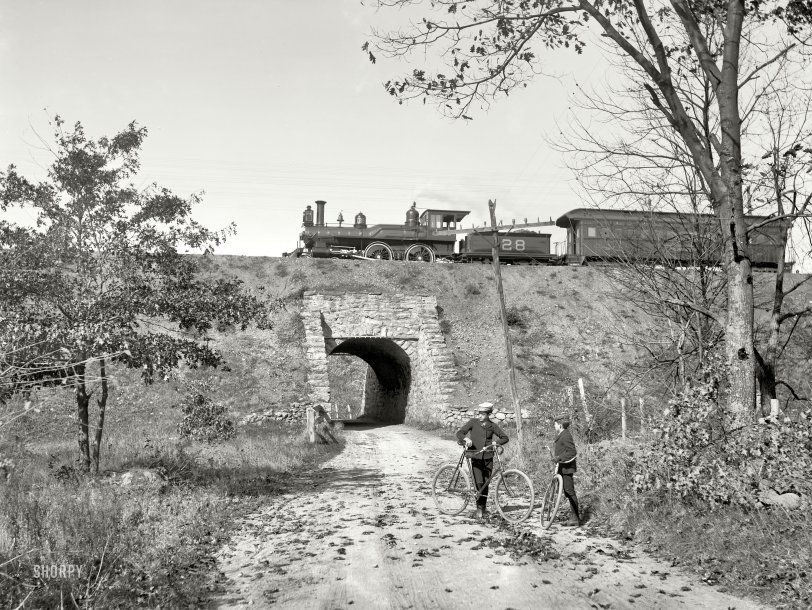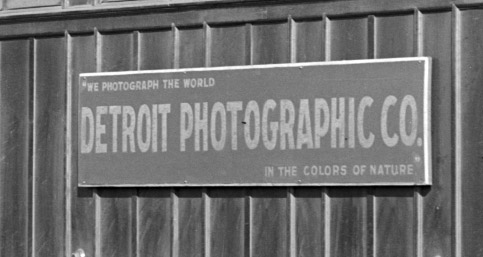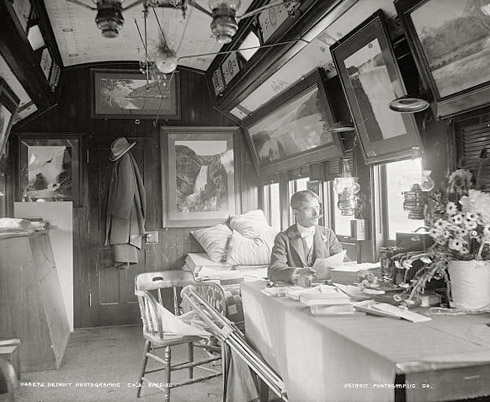


Framed or unframed, desk size to sofa size, printed by us in Arizona and Alabama since 2007. Explore now.
Shorpy is funded by you. Patreon contributors get an ad-free experience.
Learn more.

- Texas Flyer wanted
- Just a Year Too Soon
- WWII -- Replacing men with women at the railroad crossing.
- Yes, Icing
- You kids drive me nuts!
- NOT An Easy Job
- I wonder
- Just add window boxes
- Icing Platform?
- Indiana Harbor Belt abides
- Freezing haze
- Corrections (for those who care)
- C&NW at Nelson
- Fallen Flags
- A dangerous job made worse
- Water Stop
- Passenger trains have right of way over freights?
- Coal
- Never ceases to amaze me.
- Still chuggin' (in model form)
- Great shot
- Westerly Breeze
- For the men, a trapeze
- Tickled
- Sense of loneliness ...
- 2 cents
- Charm City
- What an Outrage
- Brighton Park
- Catenary Supports
Print Emporium
Over and Under: 1900

Circa 1900. "Grade separation near Arlington, New Jersey." 8x10 inch dry plate glass negative, Detroit Publishing Company. View full size.
Upgrading a bike
I noticed that the older boy has upscaled his bike to cool by flipping the handlebars over. Very racer looking.
Detroit Photographic Car
The car may have changed depending on the railroad. The Denver Public Library has quite a collection of Detroit Photographic images as well, including these showing the car and a locomotive on the Chicago and North Western railroad.
http://digital.denverlibrary.org/u?/p15330coll21,8799
http://digital.denverlibrary.org/u?/p15330coll21,8796
The car is clearly a C&NW car.
Straight skinny on the DL&W 128
I had to go through my books and look this up.
The 19th century DL&W had the peculiar practice of having separate number series for each division.
Thus, our 128 was built by Dickson in 1876 with shop number 183, as DL&W Morris and Essex Div. no. 100 [During this period, she was named, logically enough, "Centennial"]. She weighed 87000 lbs in working order, and was renumbered in the general renumbering [1899, I think] to DL&W no.128. She was scrapped in 1909.
Dickson 4-4-0 Standard?
Railway and locomotive engineering, Vol. 8, 1895.Equipment Notes
The Delaware, Lackawanna & Western have ordered two eight-wheel passenger engines from the Dickson Locomotive Works. They have received bids for 500 coal cars, and expect to award the contract this month. The road is very short of coal cars.
The pictured locomotive could be one of DL&W's Dickson Locomotive Works 4-4-0 Standard engines. Related photos on the web: here and here. The Lackawanna also owned several Dickson 4-4-0 Camelbacks but this photo is clearly not a camelback.
Slick and sleek
It looks like this loco has been 'hot rodded'. Very slick indeed.
In three years that cycle on the left looks like it might have a Harley-Davidson motor slung into its frame.
Wonderful image, once again.
Road of Anthracite
This is indeed the Delaware, Lackawanna and Western RR. The Lackawanna promoted its clean passenger service using "Hard coal, no cinders" with a creation of the ad guys known as Phoebe Snow.
A pretty lady was hired to be Miss Snow, and the campaign ran for many years before the Great War. A modern diesel powered streamliner placed in service after WWII was named "The Phoebe Snow" in honor of the original.
All of the fuss was about the DL&W burning lump anthracite, which didn't create cinders as soft coal did. The little American-type locomotive above has a long, narrow firebox [under the back end of the boiler and forward of the cab] which identifies the 128 as a lump burner.
These engines ran commuter trains from all over northern New Jersey to the Hoboken ferries at the turn of the last century. They had brief careers, however. They were replaced by larger engines that were demoted from mainline service by about 1910.
Hi-def look at the coach reveals a small "M&E" on the left end of the letterboard. This refers to the Morris and Essex Division. The coach also is lettered below the windows possibly indicating some sort of photographer's car.
[The car was the "Detroit Photographic Co. Special," which we'll be seeing more of, and whose progenitors carried DPC partner William Henry Jackson through Mexico and the American West in the 1880s and 1890s when he was exposing his "mammoth plates" -- 18x22 inch glass negatives taken by giant view cameras that were the Imax equivalent of the era, so massive they required a locomotive to haul around and develop. - Dave]

DPC Special
This special train was used by the Detroit Photographic Company to haul its photographers, equipment, and darkroom all over the country. The locomotives varied but the passenger car was specially fitted just for the company and as Dave noted, was owned by the Lackawanna. From what I understand, the DPC made at least two railroad excursion trips - one in 1899 and a second in 1902. Clearly they made other trips to gather photos that spanned several decades but the photo trains may have been more limited.
In quite a few other DPC photos you can see a locomotive pulling a single DPC passenger car somewhere in the distance. Before good roads and automobiles, the train was pretty much the only way to get anywhere that was more than a few miles away.
The photo below from the collection shows William Henry jackson sitting inside the DPC car.

The General
A picture of the boys and their bikes would be interesting enough but this is an amazing picture. There's obviously something more interesting to look at than the camera or the train. The locomotive itself reminds me of Buster Keaton's "The General."
Dressed to the nines
Both the dapper looking youngsters and that gorgeous engine! The engine, quaint even by the standards of 1900, would look like it's going 100 MPH sitting still!
Classic 4-4-0
That's about the most beautiful locomotive I've ever seen! They must have been burning special coal to have no visible smoke coming from the stack (bet it helped keep it clean too). By 1900, though, that classic layout was already considered obsolete.
You could probably see your reflection in the polished connecting rods and valve linkage.
Does anyone know what railroad this is? I can see lettering on the passenger car but can't quite read it even in HR. It isn't "PRR" (Pennsylvania, the one I remember from my NJ childhood).
[This is the Delaware, Lackawanna & Western locomotive seen earlier here. - Dave]
Two great looking wheels
and the cleanest steam locomotive on earth.
Howard Boulevard and Route 80
I remember this from when I was a kid in the sixties. That's right by the back entrance to the Hercules powder plant. Today there is a park-and-ride.
Transit Superiority
Truly the two most romantic forms of travel man has ever created.

























On Shorpy:
Today’s Top 5